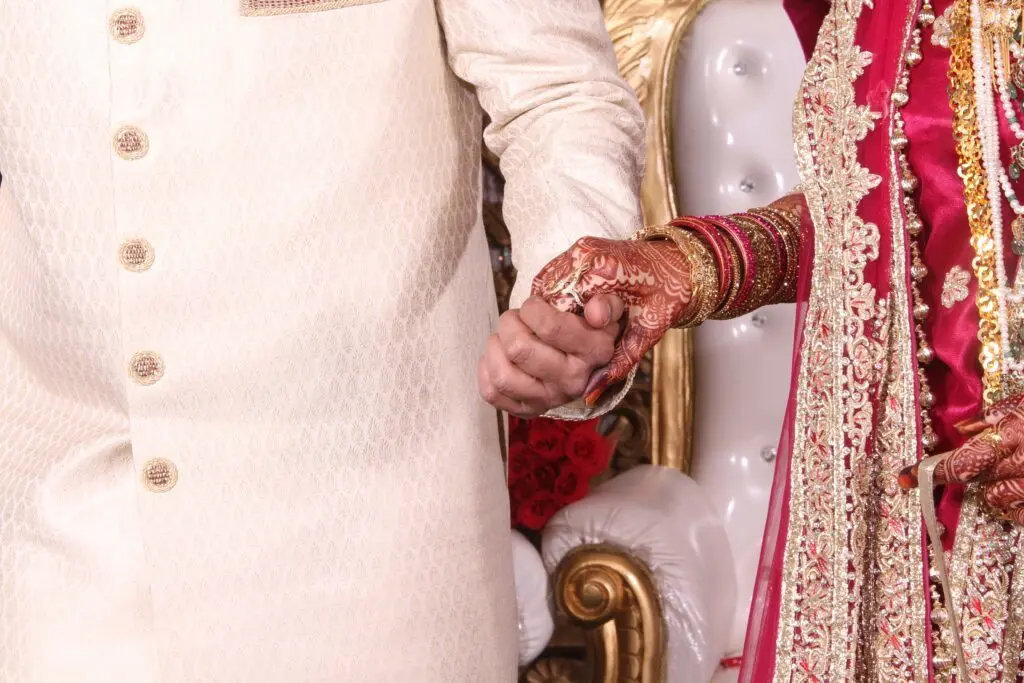
There are eight types of marriage in Hinduism per Hindu Dharmashastras. They are mentioned in the Manusmriti 3.21-35. The Sanskrit word for marriage is Vivaha. It is one of the 16 important Samskaras (rituals) in a Hindu’s life. Humans encounter different situations throughout life. In some situations, couples have to marry secretly, while some marriages took place with the consent of parents and the transaction of money takes place. In such situations, different types of marriage are useful.
Eight Types of Marriage in Hinduism:
1. Brahma Vivaha:
2. Daiva Vivaha.
3. Arsha Vivaha.
4. Prajapatya Vivaha.
5. Asura Vivaha.
6. Gandharva Vivaha.
7. Rakshasa Vivaha.
8. Paishacha Vivaha.
A. Brahma Vivaha:
“The gift of a daughter, after decking her (with costly garments) and honoring (her by presents of jewels), to a man learned in the Veda and of good conduct, whom (the father) himself invites, is called the Brahma rite.” – MS 3.27
Brahma Vivaha is the most popular of the types of marriage in Hinduism and is widely practiced. It is a type of arranged marriage. The relatives of the groom go to the bride’s home to fix the marriage.
B. Daiva Vivaha:
“The gift of a daughter who has been decked with ornaments, to a priest who duly officiates at a sacrifice, during the course of its performance, they call the Daiva rite.” – MS 3.28
This form of marriage is recommended for Brahmins only because the priests are mostly Brahmins. Generally, when the parents of a girl are unable to get her married, they resort to this form of marriage and offer their daughter as a Dakshina to a priest. It is an inferior form of marriage and is no longer practiced.
C. Arsha Vivaha:
“When (the father) gives away his daughter according to the rule, after receiving from the bridegroom, for (the fulfillment of) the sacred law, a cow and a bull or two pairs, that is named the Arsha rite.” – MS 3.29
This type of marriage was popular in ancient times in India, but nowadays, the father of the groom demands money from the father of the girl.
D. Prajapatya Vivaha:
“The gift of a daughter (by her father) after he has addressed (the couple) with the text, ‘May both of you perform together your duties,’ and has shown honor (to the bridegroom), is called the Prajapatya Vivaha.” – MS 3.30
In this form of marriage, the bride’s father goes in search of a groom.
E. Asura Vivaha:
“When (the bridegroom) receives a maiden, after having given as much wealth as he can afford, to the kinsmen and to the bride herself, according to his own will, that is called the Asura rite.” – MS 3.31
Sometimes, the groom has some abnormality but the father of the bride oversees it for greed or other reason. When the bride is extremely beautiful, many men want to marry her. If the bride’s father is greedy, he might exploit the situation.
It is an inferior form of marriage and is against Indian law, but it might be still in practice because nobody talks about such things openly.
F. Gandharva Vivaha:
“The voluntary union of a maiden and her lover one must know (to be) the Gandharva rite, which springs from desire and has sexual intercourse for its purpose.” – MS 3.32
It is mostly a love marriage. It does not require any witness or ritual. Only the couple has to agree that they accept each other as husband and wife. Shakuntala and Dushyanta married this way. This form of marriage was popular in Vedic times.
G. Rakshasa Vivaha:
“The forcible abduction of a maiden from her home, while she cries out and weeps after (her kinsmen) have been slain or wounded and (their houses) broken open, is called the Rakshasa rite.” – MS 3.33
Duryodhana-Bhanumati marriage is an example of this type of marriage. This practice was common among Kshatriyas.
H. Paishacha Vivaha:
“When (a man) by stealth seduces a girl who is sleeping, intoxicated, or disordered in intellect, that is the eighth, the most base and sinful rite of the Pisakas.” – MS 3.34.
This is the worst kind of marriage. A paishacha is a kind of a ghost. This kind of marriage is called Date Rape in modern times.
Which Castes are Allowed Which Types of Marriage in Hinduism?
Although there are eight types of marriage, not all the types are allowed for all. There are certain rules as to which caste would practice which marriage per Manusmriti.
“(They are) the rite of Brahman (Brahma), that of the gods (Daiva), that of the Rishis (Arsha), that of Prajapati (Prajapatya), that of the Asuras (Asura), that of the Gandharvas (Gandharva), that of the Rhashasas (Rakshasa), and that of the Pisakas (Paisaka).”
“Which is lawful for each caste (varna) and which are the virtues or faults of each (rite), all this I will declare to you, as well as their good and evil results with respect to the offspring.”
“One may know that the first six according to the order (followed above) are lawful for a Brahmana, the four last for a Kshatriya, and the same four, excepting the Rakshasa rite, for a Vaisya and a Sudra.”
“The sages state that the first four are approved (in the case) of a Brahmana, one, the Rakshasa (rite in the case) of a Kshatriya, and the Asura (marriage in that) of a Vaisya and of a Sudra.”
“But in these (Institutes of the sacred law) three of the five (last) are declared to be lawful and two unlawful; the Paisaka and the Asura (rites) must never be used.”
“For Kshatriyas, those before-mentioned two rites, the Gandharva and the Rakshasa, whether separate or mixed, are permitted by the sacred tradition.”
“For Kshatriyas, those before-mentioned two rites, the Gandharva and the Rakshasa, whether separate or mixed, are permitted by the sacred tradition.”
Per the current Indian law, only Brahma, Daiva, Arsha, and Prajapatya are approved forms of Hindu marriage.